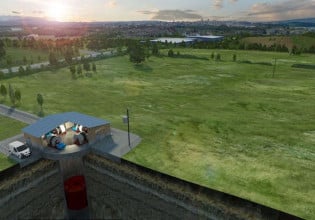Researchers Use Quantum Computing to Develop More Efficient Solar Cells
Quantum computing helps solve the challenge of singlet fission in the linear H4 molecule.
As the world looks towards creating a greener society, the role of renewables like solar and wind is becoming paramount. However, while these renewables may come across as magic bullet solutions, the truth is that their technology still has much room to grow.
A 3D illustration of a futuristic CPU quantum computer processor. Image used courtesy of Adobe Stock
Recently, researchers from Oak Ridge National Laboratory published a paper using quantum computing to unlock the puzzle of greater efficiency in solar panels. What did the researchers do, and why is it so important?
Quantum Computing and Singlet Fission
Singlet fission is a quantum process that has garnered significant attention in photophysics and renewable energy.
It's a phenomenon where the absorption of a single photon by a molecule produces two excited states. Here, an excited singlet state of a molecule splits into two triplet states, effectively converting one photon into two excitons. This process can double the number of electrons available for current generation in photovoltaic devices, enhancing their efficiency.
A schematic representation of the singlet fission process. Image used courtesy of Stoycheva et al.
Whereas conventional solar cells have a theoretical maximum efficiency of about 33%, materials that exhibit singlet fission can break that limit.
Singlet Fission Challenges
While singlet fission holds much promise for solar panels, unlocking this technique is complex. Most notably, the challenge lies in properly modeling and understanding the singlet fission process.
On a high level, classic computers struggle to model singlet fission due to the multi-excitonic nature of the process. While possible, computing methods that capture singlet fission are computationally expensive and difficult to achieve.
With their advanced computing capabilities, quantum computers offer a promising solution to this problem. However, quantum computers are still in their formative stages and prone to high error rates. These high error rates are currently the largest barrier to using quantum computers in this context.
A New Approach to Singlet Fission
Oak Ridge National Laboratory researchers recently announced that they used the Quantinuum H1-1 quantum computer to model singlet fission in the linear H4 molecule.
A representation of the measurement process used in this research. Image used courtesy of Claudino et al.
The team applied the PDS, a unique quantum solver, and utilized three independent strategies to decrease the computational workload. The PDS approach provides an effective simulation method to identify molecules that demonstrate singlet fission properties, bypassing approximations found in classical computing techniques. PDS holds notable advantages over classical strategies, offering higher accuracy and fewer computational demands.
To address the issue of error rates, the team compensated through measurement optimization, reducing the problem's size and complexity. They also used a combination of qubit tapering, measurement optimization, and parallel execution to reduce the number of required measurements and enable simulations that would otherwise be cost-prohibitive.
Fission Research Results
In the end, the research confirmed that the linear H4 molecule's energetic levels match the fission process's requirements, a critical step in developing more efficient solar panels. It also demonstrates the viability of current quantum computers to tackle scientific problems with real-world implications, validating quantum computing as a valuable tool for detailing intricate excitonic structures necessary for singlet fission.
The team believes that the techniques and approaches used in this project may be applied to other problems in quantum computing, such as the interaction of matter and light, furthering the field of materials science.









